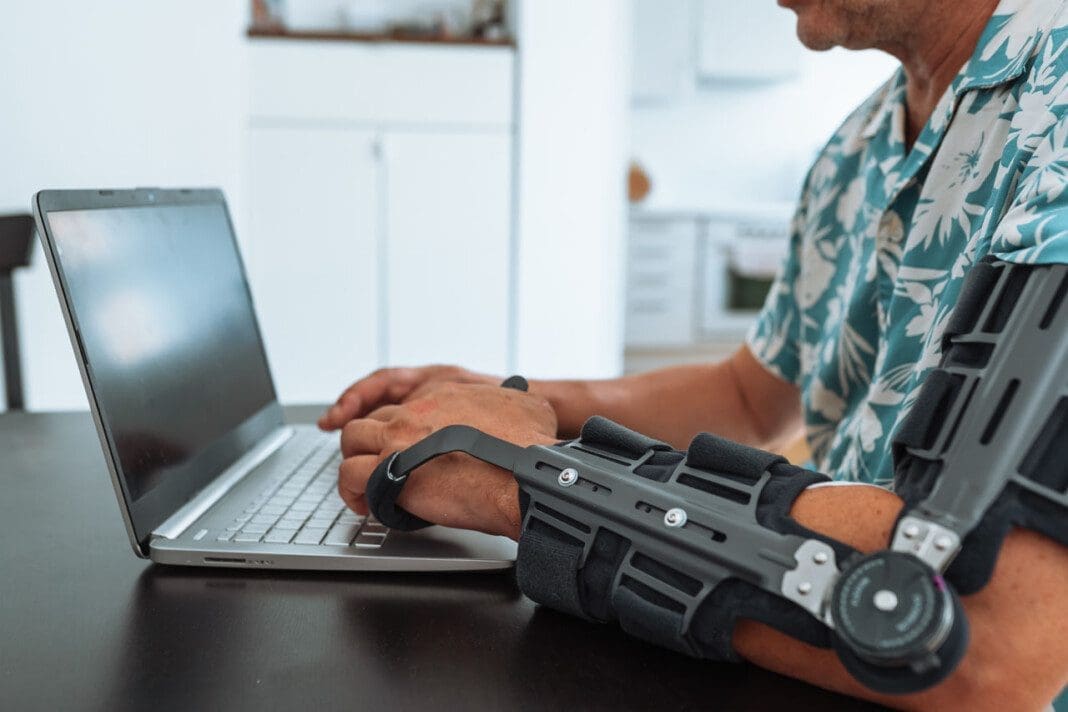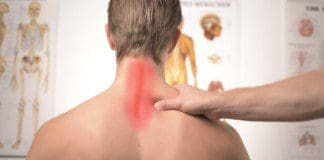“A dislocated elbow is a common injury in adults and children and often happens in tandem with bone fractures and nerve and tissue damage. Can physical therapy help to support recovery and ensure range of motion?”

Table of Contents
Dislocated Elbow Injury
Elbow dislocations are generally caused by trauma when the elbow bones no longer connect. Individuals falling onto an outstretched hand is the most common cause of the injury. (James Layson, Ben J. Best 2023) Healthcare providers will try to relocate the elbow using a closed reduction. Individuals may require surgery if they cannot relocate the elbow using closed reduction.
Resetting The Elbow
The elbow is made up of a hinge and ball-and-socket joint, enabling unique motions: (American Society for Surgery of the Hand. 2021)
Hinge joint
- The hinge function allows the bending and straightening of the arm.
Ball-and-socket joint
- The ball-and-socket function allows you to rotate the palm of your hand to face up or face down.
A dislocated elbow injury can damage bones, muscles, ligaments, and tissues. (American Academy of Orthopaedic Surgeons. 2021) The longer the elbow remains out of the joint, the more damage can occur. Elbow dislocations rarely reset into their joints on their own and are recommended to be evaluated by a qualified healthcare provider to prevent permanent damage to nerves or function.
- It is not recommended to try to reset the elbow on your own.
- A healthcare provider will work to restore the joint and ensure proper alignment.
- Before the reset, they will perform a physical examination to assess blood circulation and any nerve damage.
- Providers will order an imaging scan to examine the dislocation and identify broken bones. (American Academy of Orthopaedic Surgeons. 2021)
Type of Dislocation
The two types of elbow dislocations are: (James Layson, Ben J. Best 2023)
Posterior Dislocation
- Occurs when there is a significant force on the palm that spreads toward the elbow.
- Falling with the hands stretched out to catch yourself, and the elbow joint pushes backward/posterior.
Anterior Dislocation
- This is less common and results from applied force on a flexed elbow.
- Falling to the ground when the hand is up near the shoulder.
- In this case, the elbow joint pushes forward/anterior.
- X-rays are used to determine the type of dislocation and to identify any broken bones. (American Society for Surgery of the Hand. 2021)
- Depending on the injury, the provider may order a CT scan or MRI to ensure no damage has occurred to nerves or ligaments. (Radiopaedia. 2023)
Signs and Symptoms
A dislocated elbow injury is often caused by trauma. (American Academy of Orthopaedic Surgeons. 2021) General signs and symptoms include: (American Society for Surgery of the Hand. 2021)
- Inability to move the elbow.
- Bruising and swelling around the area.
- Intense pain in the elbow and surrounding area.
- Deformity around the elbow joint.
- Numbness, tingling, or weakness in the arm or hand can indicate nerve damage.
Treatment Without Surgery
- Healthcare providers initially try to treat a dislocated elbow using a closed reduction technique. (American Society for Surgery of the Hand. 2021)
- A closed reduction means that the elbow can be relocated without surgery.
- Before the closed reduction, a healthcare provider will administer medications to help relax the individual and address the pain. (Medline Plus. 2022)
- Once relocated into the correct position, a healthcare provider applies a splint (usually at a 90-degree angle of flexion) to keep the elbow in place. (James Layson, Ben J. Best 2023)
- The objective is to prevent elbow extension, which can cause re-dislocation.
- The splint remains in place for one to three weeks. (American Academy of Orthopaedic Surgeons. 2021)
- A physical therapist will assess motion and prescribe exercises to prevent elbow range of motion loss.
Treatment With Surgery
- Depending on the severity of the dislocation and the success of the closed reduction, surgery may still be necessary. (James Layson, Ben J. Best 2023)
- If any of the following are being experienced by the individual, a healthcare provider may recommend surgery: (American Academy of Orthopaedic Surgeons. 2021)
- The elbow remains unstable with a slight extension.
- The bones are not correctly aligning.
- The ligaments need further repair after a closed reduction.
- Complex elbow dislocations can make it difficult to maintain joint alignment.
- An assistive device, like an external hinge, may be recommended to help prevent re-dislocating the elbow.
- The surgeon will recommend physical therapy after surgery to assist with range-of-motion exercises to optimize and expedite recovery.
Recovery
- Recovery times can vary as every injury is different. (American Society for Surgery of the Hand. 2021)
- The recovery time depends on the elbow’s stability after closed reduction or surgery.
- Healthcare providers will initiate active motion exercises. (American Society for Surgery of the Hand. 2021)
- Limiting how long the joint is immobilized will prevent stiffness, scarring, and inhibited movement.
- Healthcare providers don’t recommend immobilization for more than a few weeks.
Resuming Normal Activities
Resuming regular activity often depends on the type of treatment for the elbow dislocation: (Ortho Bullets. 2023)
Closed Reduction
- The elbow is splinted for five to ten days.
- Individuals may engage in physical therapy early motion activity to help prevent loss of range of motion.
- Individuals are recommended to do light exercises within two weeks after the injury.
Surgical Reduction
- The elbow may be placed in a brace that allows for a gradual increase in motion.
- It is essential to maintain controlled movement to prevent motion loss.
- The elbow can extend fully within six to eight weeks, although it could take up to five months for complete restoration.
- The healthcare provider will determine when it’s safe to resume normal activity.
The Path to Healing Personal Injury
References
Layson J, Best BJ. Elbow Dislocation. [Updated 2023 Jul 4]. In: StatPearls [Internet]. Treasure Island (FL): StatPearls Publishing; 2023 Jan-. Available from: www.ncbi.nlm.nih.gov/books/NBK549817/
American Society for Surgery of the Hand. (2021). Elbow dislocation.
American Academy of Orthopaedic Surgeons. (2023). Elbow dislocation.
Jones J, Carroll D, El-Feky M, et al. (2023). Elbow dislocation. Reference article, Radiopaedia.org doi.org/10.53347/rID-10501
Medline Plus. (2022). Closed reduction of a fractured bone.
Ortho Bullets. (2023). Elbow dislocation.
Professional Scope of Practice *
The information herein on "Dislocated Elbow Injury: A Guide To Treatment and Recovery" is not intended to replace a one-on-one relationship with a qualified health care professional or licensed physician and is not medical advice. We encourage you to make healthcare decisions based on your research and partnership with a qualified healthcare professional.
Blog Information & Scope Discussions
Our information scope is limited to Chiropractic, musculoskeletal, physical medicines, wellness, contributing etiological viscerosomatic disturbances within clinical presentations, associated somatovisceral reflex clinical dynamics, subluxation complexes, sensitive health issues, and/or functional medicine articles, topics, and discussions.
We provide and present clinical collaboration with specialists from various disciplines. Each specialist is governed by their professional scope of practice and their jurisdiction of licensure. We use functional health & wellness protocols to treat and support care for the injuries or disorders of the musculoskeletal system.
Our videos, posts, topics, subjects, and insights cover clinical matters, issues, and topics that relate to and directly or indirectly support our clinical scope of practice.*
Our office has reasonably attempted to provide supportive citations and has identified the relevant research study or studies supporting our posts. We provide copies of supporting research studies available to regulatory boards and the public upon request.
We understand that we cover matters that require an additional explanation of how it may assist in a particular care plan or treatment protocol; therefore, to further discuss the subject matter above, please feel free to ask Dr. Alex Jimenez, DC, or contact us at 915-850-0900.
We are here to help you and your family.
Blessings
Dr. Alex Jimenez DC, MSACP, RN*, CCST, IFMCP*, CIFM*, ATN*
email: coach@elpasofunctionalmedicine.com
Licensed as a Doctor of Chiropractic (DC) in Texas & New Mexico*
Texas DC License # TX5807, New Mexico DC License # NM-DC2182
Licensed as a Registered Nurse (RN*) in Florida
Florida License RN License # RN9617241 (Control No. 3558029)
Compact Status: Multi-State License: Authorized to Practice in 40 States*
Presently Matriculated: ICHS: MSN* FNP (Family Nurse Practitioner Program)
Dr. Alex Jimenez DC, MSACP, RN* CIFM*, IFMCP*, ATN*, CCST
My Digital Business Card














